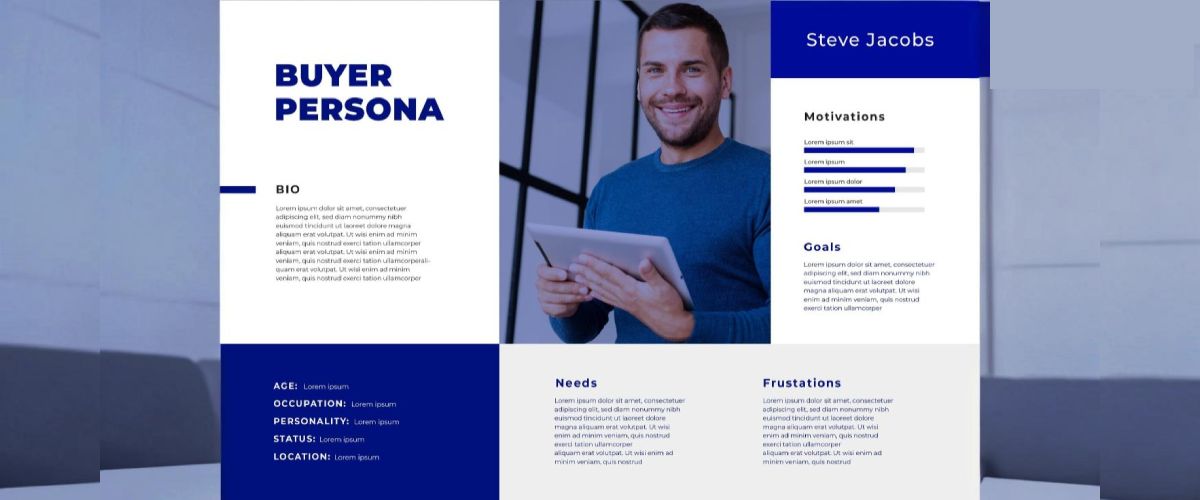
If your business wants ‘meaningful engagement’ you need a buyer persona. No matter the size of businesses, within a large market understanding and targeting different customer segments is difficult without buyer personas.
In this blog, we will explain to you what a buyer persona is and why exactly you need it. We will also discuss how to make detailed buyer personas so that you can plan your marketing campaigns and create content that engages your target audience.
What is a buyer persona?
There are two types (positive and negative) of buyer personas. We will talk about both.
A buyer persona (the positive one) is a profile that represents your ideal customer. You create this with data gathered from your market and audience research. Personas include crucial details about your target customer such as:
- Demographics (age, gender, location)
- Occupation (job title, industry)
- Lifestyle (interests, hobbies)
- Pain points (problems they face)
- Goals
- Online behavior (preferred platforms)
- buying habits
- Motivations
- Decision-making factors
To build a strong buyer persona you have to use insights that you can accumulate from your potential and existing customer base and market research. A buyer persona helps you personalize your marketing efforts and solve their problems effectively.
A negative buyer persona or an exclusionary persona is a profile that represents who you do not what as a customer. But how does that help? It will offer you knowledge with which you can narrow your strategic execution down. It will ensure your inputs contribute to your results directly. Your negative personas include:
- People who consume your content just for educational purposes
- Potential customers who are too expensive to acquire
- People who are too advanced for your service or product
A business may have only 1 or even more than 10 buyer personas depending on their business. And all businesses should create buyer personas because without clients or customers no business can be successful. It’s that simple. However, let’s be specific.
Why do you need to have a buyer persona?
Most businesses struggle to make personalized content because they lack essential information about their target audience. Let’s take a look how well-developed buyer personas can impact your business:
1. Let’s you finetune demand generation strategies
Buyer personas allow you to optimize lead nurturing content, lead generation, and demand generation strategies. The research informs you how your ideal customer prefers you to communicate (for example through SMS) so you tweak your strategies effectively.
2. Lets you personalize your marketing
Most marketers know that customers appreciate personalization and it increases the chances of their becoming repeat customers. Personalization is only possible when you know your customers very well, and the buyer persona helps you do that.
3. Helps you tailor product messaging
Not only product messaging, a complete buyer persona will help you shape your content, services, and product development in such a way that meets your target audiences’ needs the best.
4. Helps you with product development
If you conduct thorough research while making a buyer persona it would contribute greatly to your product development process too. You will have a clear idea about your ideal customer’s day to day experiences which can inspire improvements or further innovation.
How to create a buyer persona?
This would be the natural next step for you as there is no doubt that you need to invest in making buyer personas to drive growth in your business.
1. Conduct research
To create a personality that represents a key segment of your audience takes market research. Through this you will understand what your customers want you to solve, what they want, and who they are.
One of the best ways to do this is to do competitor analysis. This helps you understand how and with whom they interact. It also lets you get a read on their weaknesses and strengths which will help you during strategizing.
Social listening is another excellent way. It allows you to monitor what people say about your products, services, and brand. You can use Google Alert and look for branded hashtags on social media.
Apart from these two, you should also conduct surveys on existing customers, post on forums, gather info from website traffic analysis, your sales team’s feedback on leads, and analyze customer support requests and feedback.
2. Examine available information
About your current and potential customers you will have a lot of raw data after you have moved through the whole research process. But you have to know exactly what to do with it. Otherwise not everyone on your team would be able to understand all the data you have accumulated.
To distill the information you have gathered you need to identify commonalities and patterns in your research. You can find out how to address your persona in the most relevant way so you can turn them into customers by gaining insight from the sales team, information you get from the submitted lead forms, and answers to your interview questions.
3. Create your buyer persona
At this stage you have completed your research, collected your data, scrutinized your analytics. Now you are ready to make a buyer persona template. You can download a simple buyer persona template online and use it according to your designs.
Here’s an outline of what you can include in your buyer persona:
The second step is creating an outline of what you have gathered and learned about the motivations of your persona. This is where you will dig into the ‘why’ and distill the information you’ve amassed. For example, you should know what excites your persona the most? Who do they want to become? And finally, tie that all together by explaining how your offering can help.
4. Have conversations with the persona
There is nothing better than the language your audience speaks, for understanding what they want, what they are concerned about, and who they are. Therefore, to create a more impactful persona you should include real quotations from the interviews you had with your target audience. This is also where the mannerisms and buzzwords you have collected will be useful.
Creating a list of common objections of your target audience is an excellent idea. You can use those and address the issues with the help of your sales team during conversations with your prospective customers.
5. Create messages for your persona
With your persona you should be able to tell your team how to talk about your services or products. This includes everything from the general pitch to the vocabulary you are going to use to resonate with your persona. This is to make sure that everyone in your organization, when conversing with customers and leads, speaks the same language.
Finally, don’t forget to give your buyer persona a name, for example, Landscaper Luise, IT Idaho, Editor Ethan, Manager Morgan) would help everyone refer to each persona similarly and maintain a cross-team consistency.
Final thoughts
You need a buyer persona to understand your target customer better and make sure that everyone in your organization or team knows how to support, target, and communicate with your customers. When you use your personas to make informed-decisions there’s no doubt that you will reach more audience, increase conversion rate, and enhance customer loyalty.
You should also not forget to regularly review and update them if applicable. We can say that reviewing them once a year is a good start that will keep you on top of your target audience and their evolving preferences.
If you want an expert to handle the research work which is necessary to create a buyer persona, you can hire a virtual assistant who offers specialized skills in this domain.







